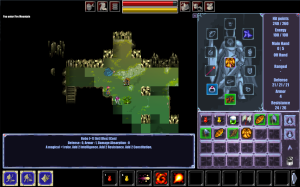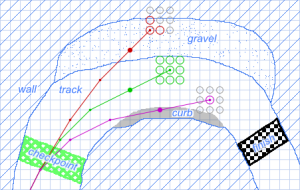I’m going to put the link to the game up top here so you don’t have to look for it. This is the important part after all, you need to play this.
Once upon a time, in 1990, there was a game called Star Control. It was all right, but not such a big thing – a series of scenarios in which you’d each fight a sequence of battles. All combat. After that, and this is important, there was another game called Star Control 2. Oh man. Star Control 2. It’s hard to describe what a big deal it was, but it’s on just about every “best games of all time” list and has absolutely earned that position.
 Explaining the how and why is going to take some work though. Have a look at this star map. Every star on it, each vertex of each constellation, is its own planetary system with some number of planets for you to land on and explore. Actual exploration on those planets is not too involved – assuming there’s nothing extraordinary to find there, no previously unknown alien structures or civilizations or artifacts, then your time on the planet consists of driving around and collecting resources while dodging natural hazards. And maybe collecting animals for a space zoo. But those resources vary in quantity and quality, those natural hazards can be problematic, and that unknown alien stuff is out there for a diligent explorer to make known.
Explaining the how and why is going to take some work though. Have a look at this star map. Every star on it, each vertex of each constellation, is its own planetary system with some number of planets for you to land on and explore. Actual exploration on those planets is not too involved – assuming there’s nothing extraordinary to find there, no previously unknown alien structures or civilizations or artifacts, then your time on the planet consists of driving around and collecting resources while dodging natural hazards. And maybe collecting animals for a space zoo. But those resources vary in quantity and quality, those natural hazards can be problematic, and that unknown alien stuff is out there for a diligent explorer to make known.
“All right,” you say, rolling your eyes, “It’s a sandbox game. You could have just said that.” Fine. Yes, that’s what it is. That’s just the setting though, it’s a wonderful environment but there’s a game here too – all of that exploration does have a point. I’m strongly adverse to spoilers, so I’ll just say this: the game manages to pull off the comedy / drama balance extraordinarily well, giving the player plenty of funny moments and quirky aliens, while setting up a dramatic conflict with some tension and feeling.
The closest modern comparison I can think of is the Grand Theft Auto series, which feels somewhat similar in terms of environment and story presentation, though with a wildly different style. Obviously the GTA series has all of the modern advantages, from improved graphics to more refined game mechanics, but one thing that the GTA series consistently fails to do is really take advantage of its massive environments. Driving down the street and seeing rows of houses and buildings gives a sense of size and immersion, but ultimately those buildings are just decoration. You can’t go inside or really interact with the majority of them in any significant way. In that respect the element of exploration is mostly lost – the more you play the more it becomes clear that this city which you’re moving through really just consists of a few locations of meaning and a bunch of obstacles in between. Nice obstacles, which can be fun to blow up, but which have no significance in themselves.
Contrast that with the need to continually seek out the most resource-rich worlds to mine while going about your other adventures. Even when you have some other plot-related reason to travel to a star system, you’ll often want to check out the nearby systems just to see what’s there and if they have any resources worth taking. In this way all of the locations in Star Control 2 matter. Maybe not a lot, but just that little bit turns it from a game of traveling the galaxy to a game of exploring the galaxy.
There’s another aspect here which I think adds something but which you no longer see in modern games, a physical component – you need to take notes. By the time you’re done with the game you’ll have a couple of pages worth of scribbled notes about locations to check, possible leads on something you’re trying to find, or maybe just a to-do list of things you’d like to get to. The game does none of this for you, no log of significant bits of conversation that you’ve scrolled past, no highlights on your star map of where you’ve been told to look. It’s… odd how much the additional work of doing this yourself adds to the experience. In some respects the labor of doing something yourself, while not inherently enjoyable, makes that thing yours. It gives you ownership of your successes and a commitment to see it done right. There’s probably an essay to be written on how this applies to games in a more general sense, but I’ll save that for another time.
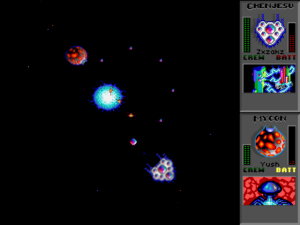 So counting off all that made SC2 great, that’s two things so far: a strong narrative and a sense of exploration. The final major gameplay element is combat and, surprising to me when I first played it, combat in SC2 is all action. It’s not at all the cerebral turn-based experience which I expected from a plot-driven exploratory game. Instead, it’s a fast-paced duel between spaceships which goes the extra mile of recognizing that there’s no atmosphere in space, and thus no drag (though there is an artificial speed limit in order to keep things reasonable). Think of something similar to Asteroids and you’ll get the idea (or Spacewar, if you’re familiar with that), although even Asteroids had drag. Not many games abide by that particular physical law, but I highly recommend Escape Velocity: Nova if you’re looking for another game which does. EV: Nova almost certainly drew inspiration from Star Control 2.
So counting off all that made SC2 great, that’s two things so far: a strong narrative and a sense of exploration. The final major gameplay element is combat and, surprising to me when I first played it, combat in SC2 is all action. It’s not at all the cerebral turn-based experience which I expected from a plot-driven exploratory game. Instead, it’s a fast-paced duel between spaceships which goes the extra mile of recognizing that there’s no atmosphere in space, and thus no drag (though there is an artificial speed limit in order to keep things reasonable). Think of something similar to Asteroids and you’ll get the idea (or Spacewar, if you’re familiar with that), although even Asteroids had drag. Not many games abide by that particular physical law, but I highly recommend Escape Velocity: Nova if you’re looking for another game which does. EV: Nova almost certainly drew inspiration from Star Control 2.
Recognizing that this has gotten long I’ll just say that the combat does its job well – each alien species has its own unique style of ship with its own unique abilities which really serve to distinguish them from one another in a large way, no palette-swapping here, and the mechanics of the combat manage to make it exciting and challenging without dragging it out. It compliments the rest of the game effectively, and allows for a large quantity of combat without slowing things down. Also: that’s how the combat worked in Star Control 1, so it’s not like they were going to just turn the franchise on its head.
These are the major three elements which make the game work so well. Naturally the devil’s in the details, but you’re going to have to see those for yourself. Good news: it’s free! Back in 2002 the developers decided to open source the 3DO version of the game, the best official version, but they didn’t have the rights to the name Star Control. Since the full title of the game is Star Control 2: The Ur-Quan Masters, we now have the open source project titled: The Ur-Quan Masters. But that’s not all. As an open source project that’s been around for a while, and a game which is the subject of much love, there are mods and improvements to be had. In particular, let me direct you to The Ur-Quan Masters: High Definition, a project attempting to modernize the graphics of this now twenty-three year old game. There’s also a group which has released several remix albums of the game music, called The Precursors.
Finally, if you play the game and find yourself to be a fan there’s an official unofficial fandom site called The Pages of Now and Forever which covers pretty much everything related to Star Control. Including forums, if you have a question or just want to express your enthusiasm.
Star Control and Star Control 2 (but not Star Control 3) were developed by a then-obscure company called Toys for Bob. It was led by a two man team at the time and they’re still around today, still making games and still lead by those same two people. Nowadays they’re owned by Activision and are best known for creating the Skylanders franchise which has, according to Wikipedia, sold more than $3 billion worth of games and little plastic figurines. If you haven’t played Skylanders… well I don’t blame you. It’s a money sink. If you dismiss it just because it’s a kids’ game though, you’re missing out (on more than just this, there’s a lot of quality entertainment aimed at children). Toys for Bob is still a great developer, and it shows.
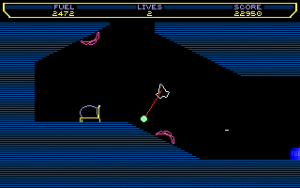 Cave fliers are games consisting of moving against gravity, almost always through enclosed spaces and usually by means of a single propulsion mechanism which has to be aimed in order to direct your motion. The most common way this is implemented is something along the lines of Asteroids – you can fire your rocket to move forward, wherever you’re pointed, and you can also rotate, and that’s it. Those are your movement controls. The difficulty is mostly about the strength of gravity and your rocket, and how forgiving the ground is when you run into it. There are often enemies and some element of combat, but that’s not usually the focus. Frequently, just to make to make things harder, there’s also cargo involved – something heavy to be awkwardly transported.
Cave fliers are games consisting of moving against gravity, almost always through enclosed spaces and usually by means of a single propulsion mechanism which has to be aimed in order to direct your motion. The most common way this is implemented is something along the lines of Asteroids – you can fire your rocket to move forward, wherever you’re pointed, and you can also rotate, and that’s it. Those are your movement controls. The difficulty is mostly about the strength of gravity and your rocket, and how forgiving the ground is when you run into it. There are often enemies and some element of combat, but that’s not usually the focus. Frequently, just to make to make things harder, there’s also cargo involved – something heavy to be awkwardly transported.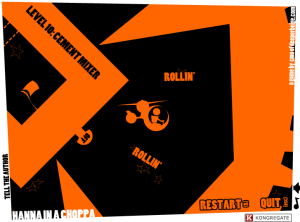 Hanna in a Choppa is a flash game from 2008 which takes the old model and does away with a lot of the difficulty, while adding some humor and a whole lot of orange. In some respects it could be described as a little dumbed-down, most of what makes it easier is a control scheme that operates in world space: from the perspective of the player rather than from the perspective of the player-character. So up always means up, no matter which direction the PC is facing. This doesn’t make physical sense, but it does make for a light and enjoyable game. The developer agonized a bit over this decision, and wrote an article describing the design process here.
Hanna in a Choppa is a flash game from 2008 which takes the old model and does away with a lot of the difficulty, while adding some humor and a whole lot of orange. In some respects it could be described as a little dumbed-down, most of what makes it easier is a control scheme that operates in world space: from the perspective of the player rather than from the perspective of the player-character. So up always means up, no matter which direction the PC is facing. This doesn’t make physical sense, but it does make for a light and enjoyable game. The developer agonized a bit over this decision, and wrote an article describing the design process here.